Vietnam is home to an incredible array of avian life. From the rare and endangered to the common and widespread, birds of all shapes, sizes, and colors can be found throughout the country.
The diverse habitats of Vietnam provide a wealth of opportunities for birdwatching and nature exploration, giving visitors a unique chance to observe birds in their natural environment. From spectacular waterbirds to colorful parrots, Vietnam is a paradise for bird lovers.
1. Germain’s Peacock-Pheasant
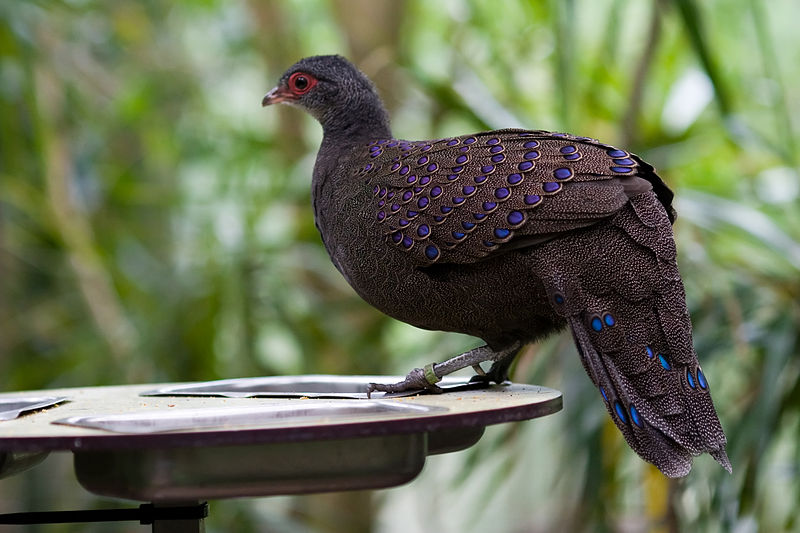
Germain’s peacock-pheasant is a beautiful bird endemic to Indochina, named after French colonial army veterinary surgeon Louis Rodolphe Germain. It has a medium size of about 60 cm in length and its plumage is brownish dark with finely spotted buff colouring.
The bird also features a short crest, bright red facial skin and a light brown iris. One of the most outstanding characteristics of this species are its purplish blue ocelli located on the upper body plumage as well as half of its tail feathers which makes it unique among other pheasants found in Asia.
This colourful creature can be seen living primarily in montane forests where it feeds mostly on insects, small rodents and fruits making them an important part of the ecosystem they inhabit due to their role as seed dispersers for many plant species that provide food sources for both animals and humans alike.Scientific classification:
| Kingdom | Animalia |
| Phylum | Chordata |
| Class | Aves |
| Order | Galliformes |
| Family | Phasianidae |
| Genus | Polyplectron |
| Species | P. germaini |
2. Edwards’s Pheasant
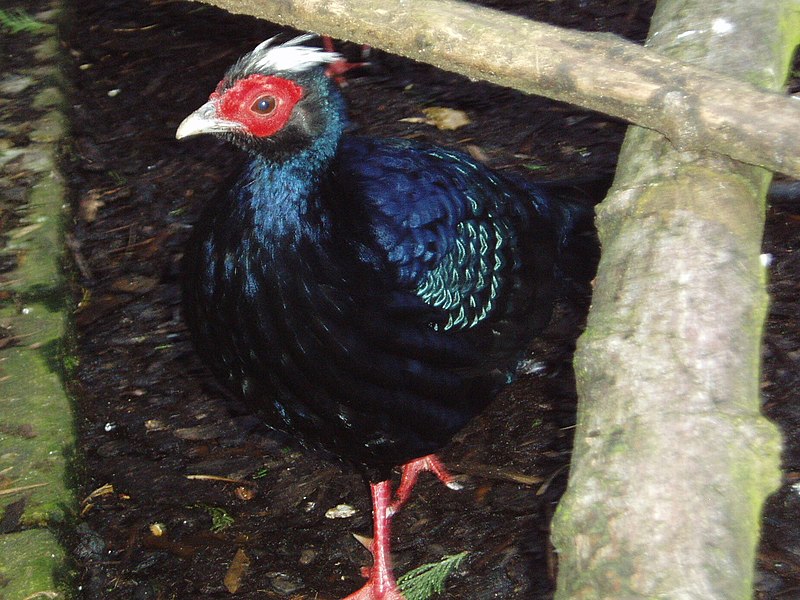
Edwards’s pheasant is a stunningly beautiful bird endemic to the rainforests of Vietnam. It was first described by French ornithologist Alphonse Milne-Edwards in 1896 and named after him.
The male has an impressive crest, while both sexes have red legs and facial skin. Males are mainly blue-black in colour with some lighter hues on their wings, while females have drab brown feathers that help them blend into their environment better when searching for food or avoiding predators.
These birds can grow up to 58–65 centimetres (23–26 in) long and make loud calls during mating season which echo through the forests of Vietnam.Scientific classification:
| Kingdom | Animalia |
| Phylum | Chordata |
| Class | Aves |
| Order | Galliformes |
| Family | Phasianidae |
| Genus | Lophura |
| Species | L. edwardsi |
3. Bar-Bellied Pitta
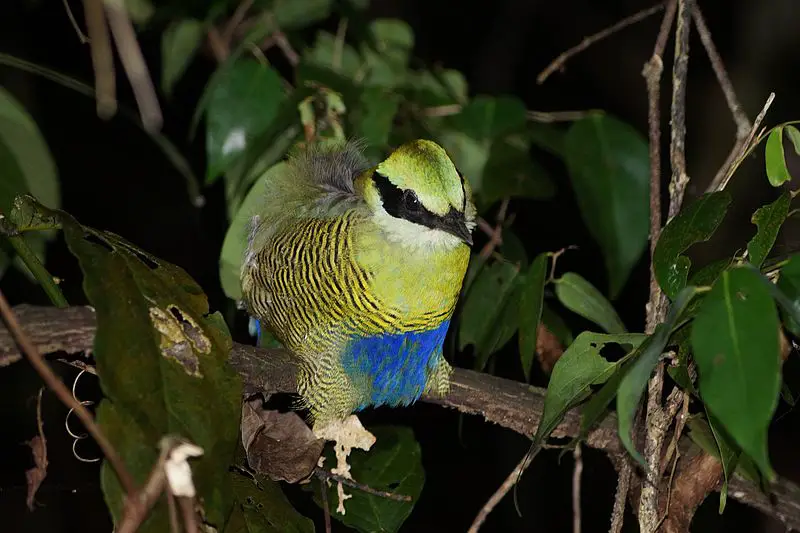
The Bar-bellied pitta is a species of bird in the Pittidae family, found in Cambodia, Laos, Thailand and Vietnam. It inhabits seasonal tropical forests and has an attractive plumage with blue upperparts and yellowish bars on its breast.
The male has a red head while females are duller overall but have bright orange underparts.
These birds feed mainly on invertebrates such as insects which they catch by hopping along the ground or gleaning from foliage. They also eat some fruit like wild figs or berries when available.
Their nests are built low to the ground within thick vegetation near streams; both parents share incubation duties for up to two weeks before chicks hatch out ready to explore their new world.Scientific classification:
| Kingdom | Animalia |
| Phylum | Chordata |
| Class | Aves |
| Order | Passeriformes |
| Family | Pittidae |
| Genus | Hydrornis |
| Species | H. elliotii |
4. Golden-Winged Laughingthrush
The Golden-winged Laughingthrush is an amazing bird species endemic to Vietnam. It features a striking combination of colors, with bright golden wings and laughter-like calls.
This beautiful creature inhabits the subtropical or tropical moist forests found in its natural habitat, but unfortunately it faces threats due to human activity that has caused deforestation and destruction of these habitats.
Conservation efforts are needed if this special bird is to be preserved for future generations. The population of Golden-winged Laughingthrushes stands at risk as their home environment continues to diminish; however, awareness can help bring attention towards conservation efforts that will hopefully save this unique species from extinction.Scientific classification:
| Kingdom | Animalia |
| Phylum | Chordata |
| Class | Aves |
| Order | Passeriformes |
| Family | Leiothrichidae |
| Genus | Trochalopteron |
| Species | T. ngoclinhensis |
5. Grey-Crowned Crocias
The Grey-crowned Crocias is a passerine bird that is endemic to Vietnam. It has an extremely limited range, being found in the Da Lat Plateau and Kontum Plateau regions of central Vietnam.
This species prefers intact broadleaf evergreen forest or secondary growth forests, where it can be seen foraging on the ground or low vegetation levels.
The Grey-crowned Crocias has drab greyish plumage with black wings and tail feathers along with faint yellow edges around its crown, nape and breast areas.
Despite this restricted distribution area, population numbers remain stable due to conservation efforts within these two protected mountain plateaus.Scientific classification:
| Kingdom | Animalia |
| Phylum | Chordata |
| Class | Aves |
| Order | Passeriformes |
| Family | Leiothrichidae |
| Genus | Laniellus |
| Species | L. langbianis |
6. Collared Laughingthrush
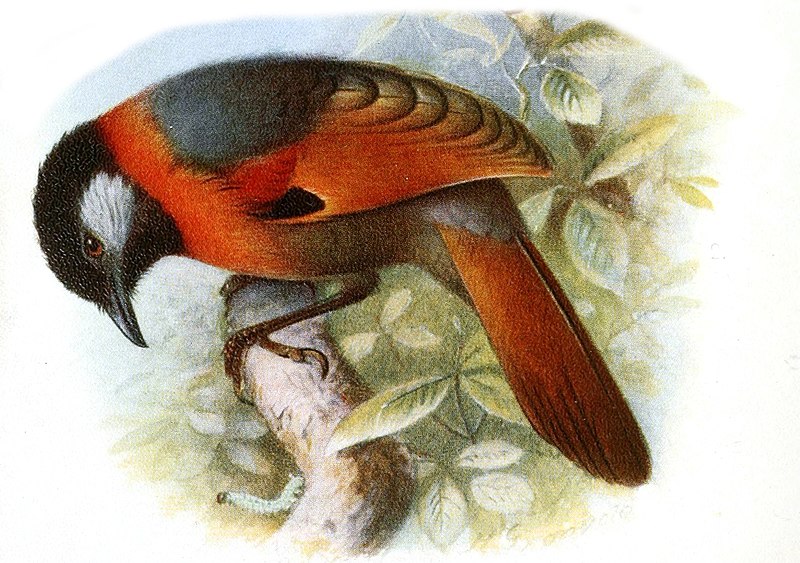
The Collared Laughingthrush is an endemic bird species found in Vietnam. It has a unique plumage, with white cheeks and throat, black crown and back of the head, reddish breast and grey wings.
This beautiful bird inhabits montane forests and high-altitude shrublands where it feeds on insects, fruits, flowers or seeds as part of its diet.
Unfortunately this species is threatened by habitat loss caused by deforestation due to expanding human activities such as logging or agricultural practices that are taking place in their natural habitats.
Conservation efforts must be put into place if we want to ensure the survival of this charming little bird for future generations.Scientific classification:
| Kingdom | Animalia |
| Phylum | Chordata |
| Class | Aves |
| Order | Passeriformes |
| Family | Leiothrichidae |
| Genus | Trochalopteron |
| Species | T. yersini |
7. Red-Vented Barbet
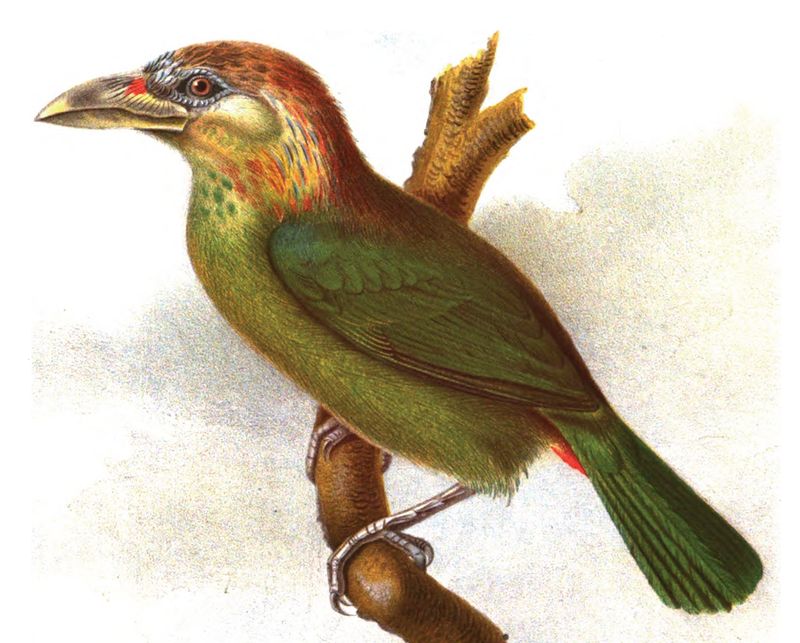
The red-vented barbet is a small but striking bird native to Laos, Vietnam and Cambodia. It inhabits subtropical or tropical moist lowland forest and montane forests.
Its plumage is green to bronze in color with brown on the head, greyish patches on the throat and sides as well as having a blue line above its eyes. The most prominent feature of this species however is its bright red patch below the tail which helps give it an eye catching appearance.
These birds are quite sociable making them popular amongst avian enthusiasts who enjoy watching their interactions between members of each flock. As they feed mainly off fruits they make ideal garden visitors for those interested in attracting wildlife into their gardens with food sources such as fruit trees or berry bushes .Scientific classification:
| Kingdom | Animalia |
| Phylum | Chordata |
| Class | Aves |
| Order | Piciformes |
| Family | Megalaimidae |
| Genus | Psilopogon |
| Species | P. lagrandieri |
8. Blue-Rumped Pitta
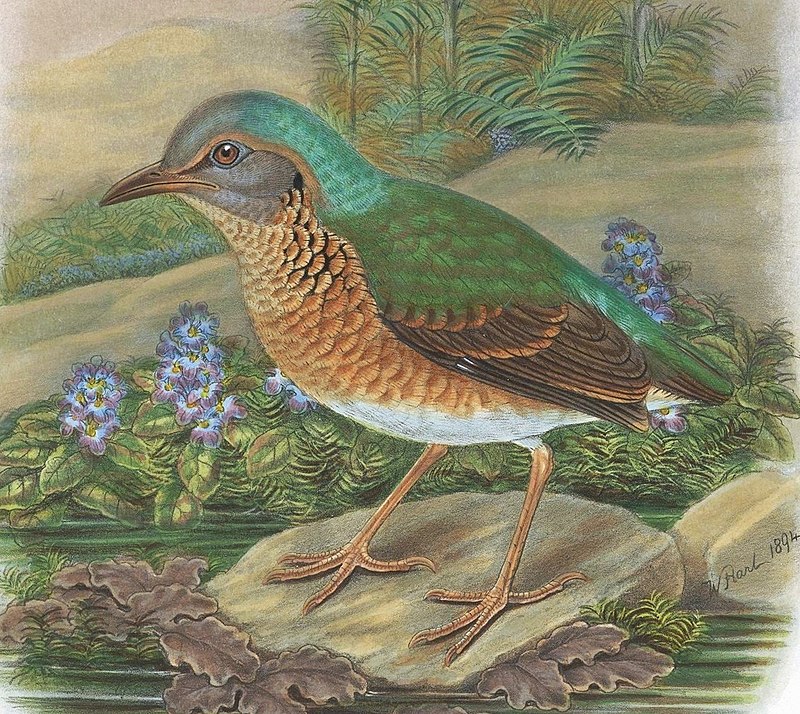
The stunning Blue-rumped Pitta is a species of bird found in parts of Cambodia, China, Laos, Thailand and Vietnam. They inhabit subtropical or tropical moist lowland forests as well as montane forests.
The birds have an overall blueish plumage with a bright yellow head and breast. Their backs are brown while the tail feathers show off shades of green and purple – making them quite eye catching.
First described by English naturalist Robert George Wardlaw-Ramsay back in 1881 from a specimen collected in Saigo; they can now be spotted throughout their native range flying between trees looking for insects to feed on.Scientific classification:
| Kingdom | Animalia |
| Phylum | Chordata |
| Class | Aves |
| Order | Passeriformes |
| Family | Pittidae |
| Genus | Hydrornis |
| Species | H. soror |
9. White-Eared Night Heron
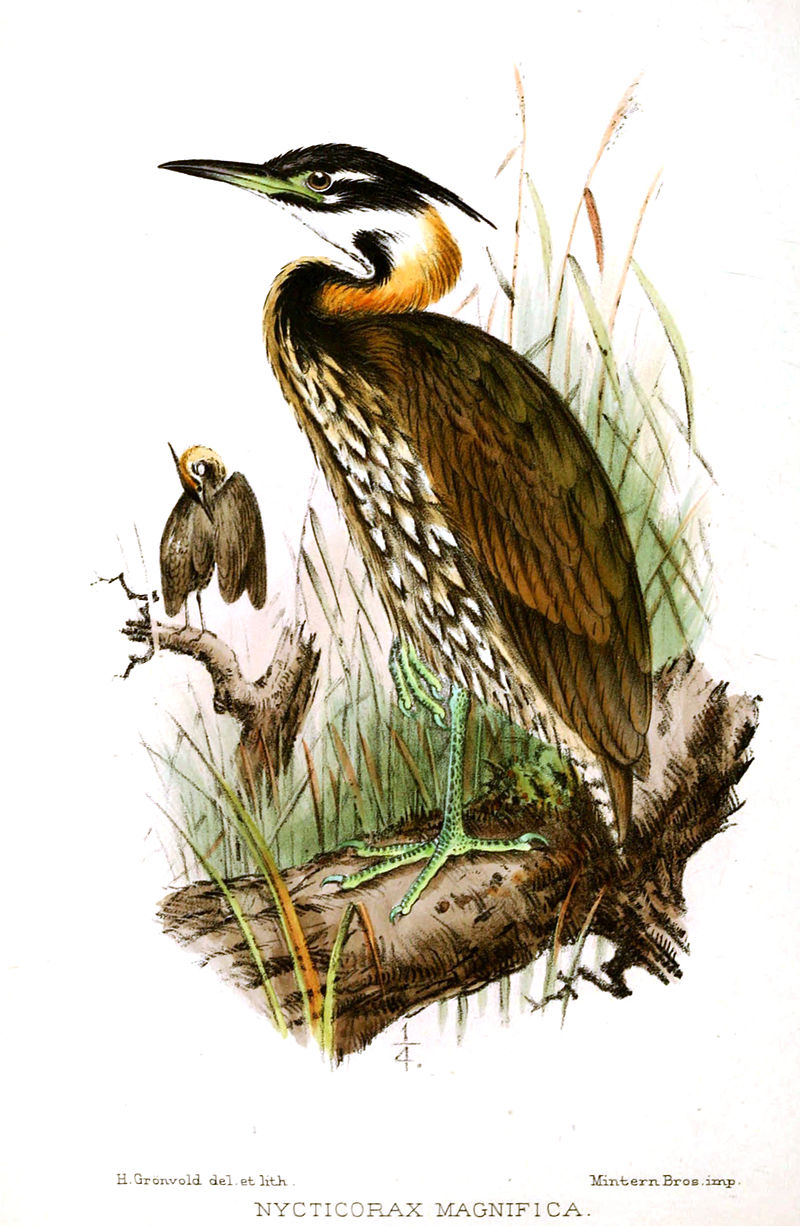
The white-eared night heron is a species of bird in the Ardeidae family native to southern China and northern Vietnam.
It was first collected by John Whitehead on Hainan Island, and described as Nycticorax magnifica b.
Unfortunately, due to habitat loss and fragmentation, this species is currently threatened with extinction.
In 2018 it was also reported from Valmiki National Park in India which offers new potential for conservation efforts.
The white-eared night heron has striking features such as its dark blue bill, bright yellow legs and large distinctive ear tufts that make up most of its face giving them their namesake appearance.
With proper protection measures put into place they have hope of avoiding further decline or even becoming extinct altogether.Scientific classification:
| Kingdom | Animalia |
| Phylum | Chordata |
| Class | Aves |
| Order | Pelecaniformes |
| Family | Ardeidae |
| Genus | Gorsachius |
| Species | G. magnificus |
Also Featured In: Common Birds of Hainan,
10. Vietnamese Greenfinch
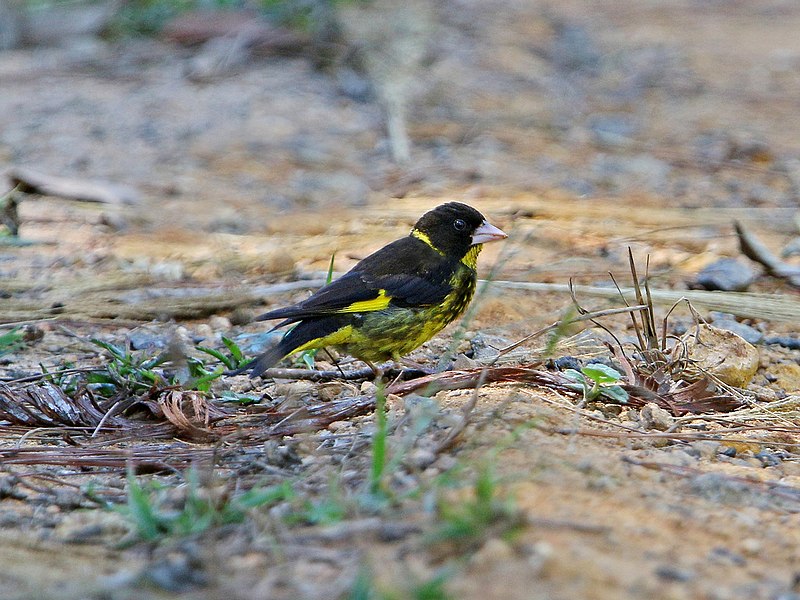
The Vietnamese greenfinch is a small passerine bird found only in Da Lat, Vietnam. It has an olive-green body with white wingbars and black streaking on its head, chest, and back.
Its bill is yellowish and its legs are pinkish. This species inhabits subtropical or tropical dry forests that are being threatened by habitat loss due to deforestation for agricultural purposes or urban expansion.
The first formal description of the Vietnamese greenfinch was done by American ornithologist Jean Théodore Delacour in 1926 under the binomial name Hypacanthis monguilloti.
Conservation efforts must be put into place if this vulnerable species is going to survive long term in their native environment which faces increasing human pressure from logging activities as well as other forms of land conversion activity such as road construction projects occurring nearby these habitatsScientific classification:
| Kingdom | Animalia |
| Phylum | Chordata |
| Class | Aves |
| Order | Passeriformes |
| Family | Fringillidae |
| Subfamily | Carduelinae |
| Genus | Chloris |
| Species | C. monguilloti |
11. Red-Collared Woodpecker
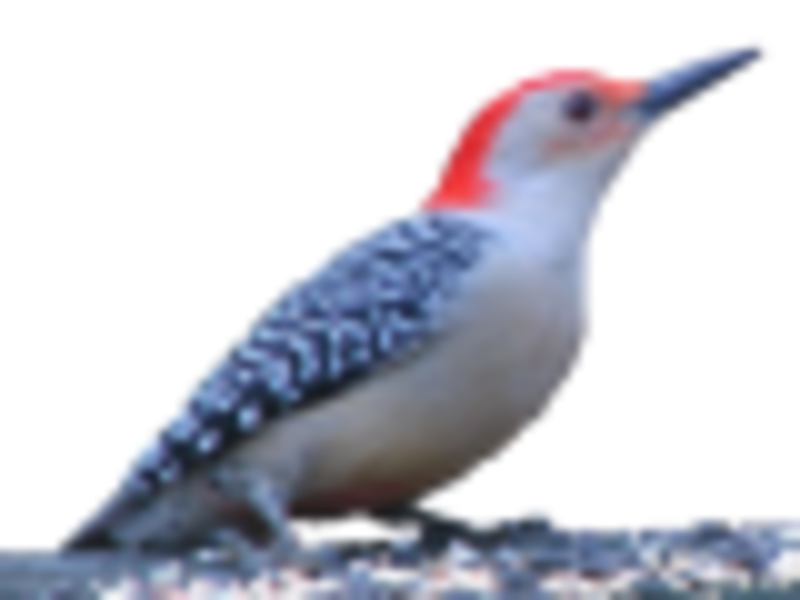
The red-collared woodpecker is a beautiful species of bird that belongs to the family Picidae. It can be found in certain parts of Cambodia, China, Laos and Vietnam living in temperate forests.
Unfortunately it is under threat due to habitat loss caused by human activity such as deforestation for agricultural land or logging.
If we want this stunning creature to remain with us for generations then we need to take action now and protect its natural environment before it’s too late.
By preserving their habitats through regulations regarding forestry practices and increased awareness about conservation efforts made on behalf of these birds, we may be able preserve them from extinction thus allowing future generations the pleasure of seeing them in our skies.Scientific classification:
| Kingdom | Animalia |
| Phylum | Chordata |
| Class | Aves |
| Order | Piciformes |
| Family | Picidae |
| Genus | Picus |
| Species | P. rabieri’ |
12. Black-Crowned Barwing
The Black-crowned Barwing is a beautiful bird native to Indochina. It belongs to the family of Leiothrichidae, also known as laughingthrushes and allies.
This non-migratory species has a distinct ray-like tail which gave it its name: Actinodura sodangorum – derived from Greek words meaning “ray” and “Södang tribe”.
The black feathers on its crown make this bird easily recognizable while their greyish wings are edged with white bars that become visible in flight. They inhabit areas such as Ngoc Linh (Vietnam), Cambodia, Laos where they feed mainly on insects.
Despite being less popular than other birds due to lack of research data, the Black Crowned barwing remains an integral part of the region’s biodiversity.Scientific classification:
| Kingdom | Animalia |
| Phylum | Chordata |
| Class | Aves |
| Order | Passeriformes |
| Family | Leiothrichidae |
| Genus | Actinodura |
| Species | A. sodangorum |
13. Black-Throated Sunbird
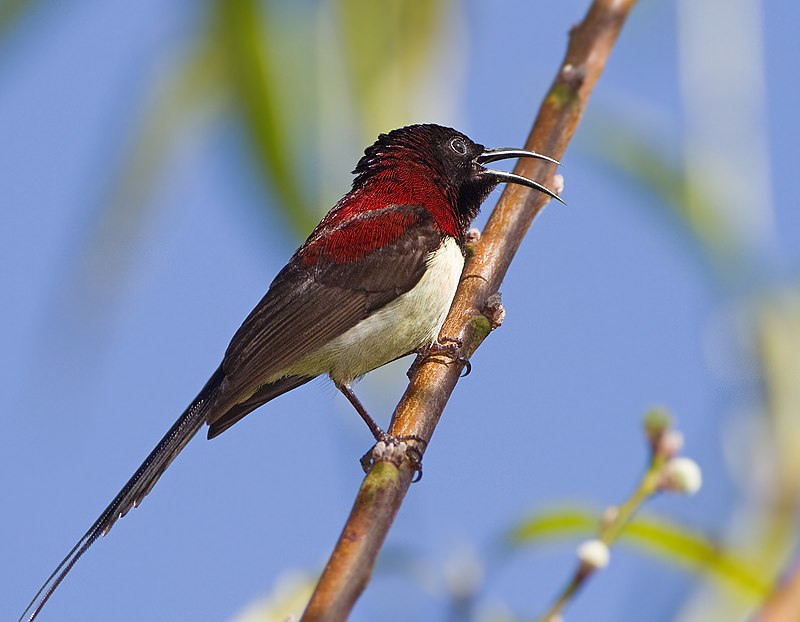
The Black-throated Sunbird is a species of bird from the Nectariniidae family found in parts of South Asia and Southeast Asia. It has a striking black face, throat and chest with patches of yellow on its wings and tail feathers.
Its natural habitats are moist lowland forests or montane areas where it feeds mainly on nectar from flowers using its long curved bill to reach deep into them. Insects also make up part of their diet, which they catch by hovering near the ground before diving down to snatch them up.
They form monogamous pairs during breeding season that nest high off the ground in shrubs or trees while singing melodious songs together as they build their nests out of twigs, mosses and lichens bound together with spider webs.Scientific classification:
| Kingdom | Animalia |
| Phylum | Chordata |
| Class | Aves |
| Order | Passeriformes |
| Family | Nectariniidae |
| Genus | Aethopyga |
| Species | A. saturata |
14. White-Shouldered Ibis
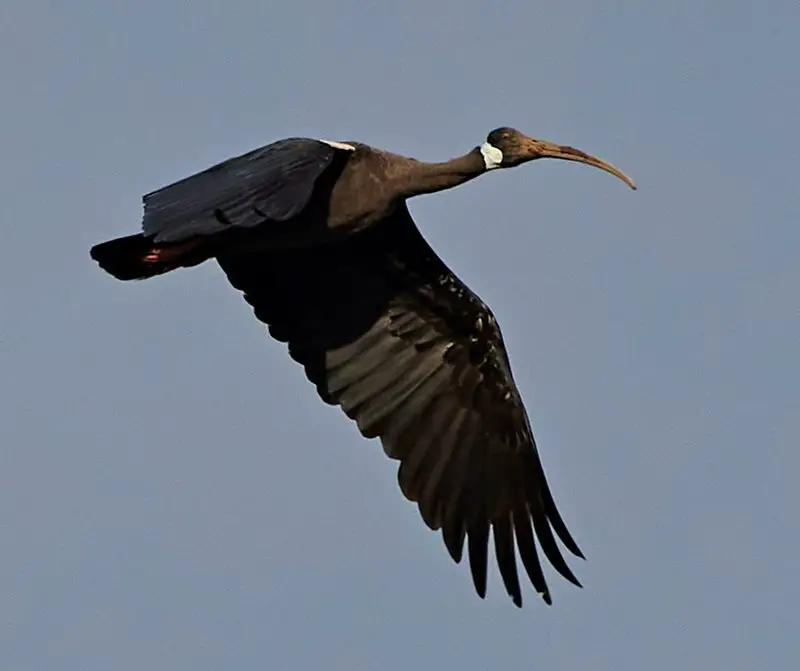
The white-shouldered ibis is a large species of bird found in small regions of Southeast Asia, and unfortunately it’s one of the most endangered birds on this part of the continent.
It was originally named Geronticus davisoni by Hume (1875) after his bird collector Willi.
This species has a distinct black bill with whitish facial skin patches surrounding its eyes and extending down to its throat.
While its back, wings and tail are greyish-brown with an iridescent sheen when viewed at certain angles.
However, their main feature that sets them apart from other birds is their white shoulder feathers which give rise to their name.
These magnificent creatures face many threats including human activities such as habitat destruction caused by agricultural expansion or logging for timber, making conservation efforts crucial for saving these unique birds from extinction.Scientific classification:
| Kingdom | Animalia |
| Phylum | Chordata |
| Class | Aves |
| Order | Pelecaniformes |
| Family | Threskiornithidae |
| Genus | Pseudibis |
| Species | P. davisoni |
15. Siamese Fireback
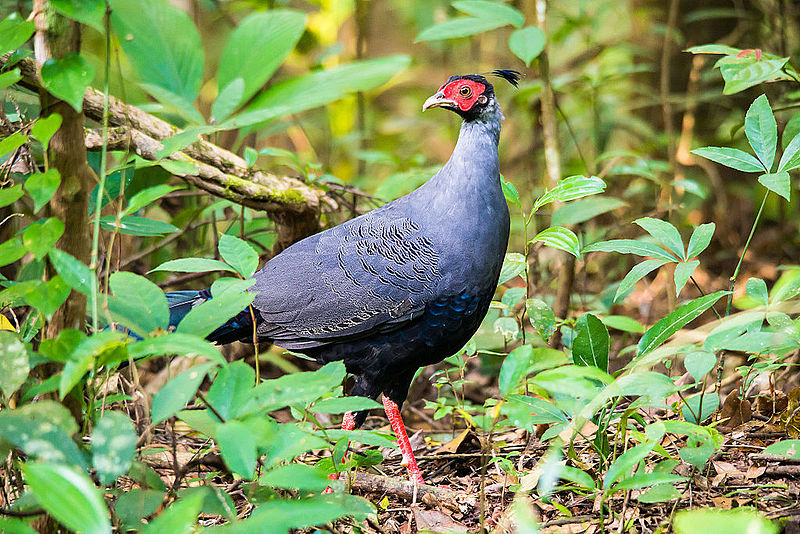
The Siamese fireback is a magnificent bird, native to Southeast Asia. It stands about 80 cm tall and has grey plumage with an extensive facial caruncle, crimson legs and feet, ornamental black crest feathers, reddish brown iris and long curved tail feathers.
The female of the species is noticeably different from the male – she sports a glossy brown body with striking blackish wings and tail feathers. This pheasant’s range stretches across Thailand, Malaysia, parts of Laos as well as western Cambodia.
They prefer lowland forests but can also be found in secondary habitats close to rivers or streams where they feed on insects like grasshoppers or other invertebrates while searching for fruits during fruiting season too.
In general these birds are shy yet curious creatures that make delightful noises throughout their habitat bringing life into any environment they inhabit.Scientific classification:
| Kingdom | Animalia |
| Phylum | Chordata |
| Class | Aves |
| Order | Galliformes |
| Family | Phasianidae |
| Genus | Lophura |
| Species | L. diardi |
16. Silver Pheasant
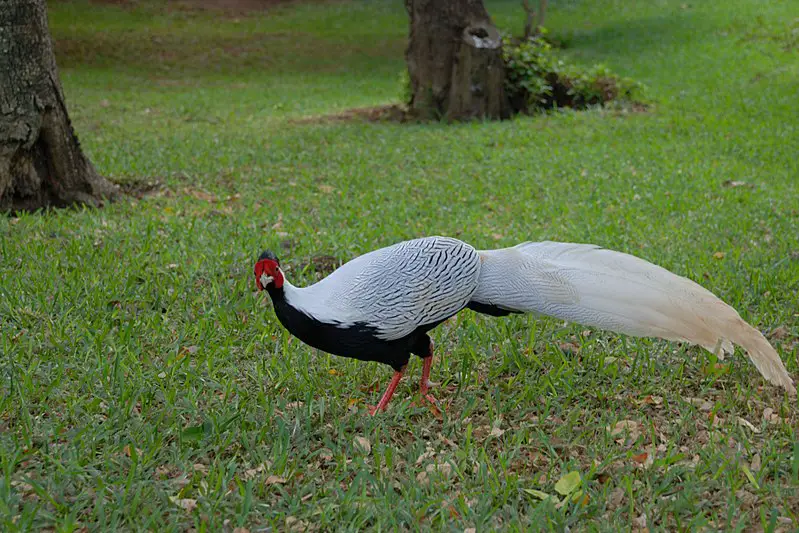
The Silver Pheasant is a stunningly beautiful bird native to parts of Southeast Asia, Eastern and Southern China. This species is known for its distinct black and white feathers in the males, while females are mainly brown.
They both have bare red faces and legs which sets them apart from other birds such as the Golden Pheasant.
The Silver pheasant lives mainly in mountain forests where it feeds on various types of insects, fruits, buds, shoots and seeds.
It has even been introduced to Argentina’s Victoria Island at Nahuel Huapi Lake.
These gorgeous creatures are also popular among aviculture enthusiasts who appreciate their majestic beauty – just be sure to provide plenty of space for these large birds if you hope to keep one as a pet.Scientific classification:
| Kingdom | Animalia |
| Phylum | Chordata |
| Class | Aves |
| Order | Galliformes |
| Family | Phasianidae |
| Genus | Lophura |
| Species | L. nycthemera |
Also Featured In: Silver Birds You Should Know,
17. Pied Falconet
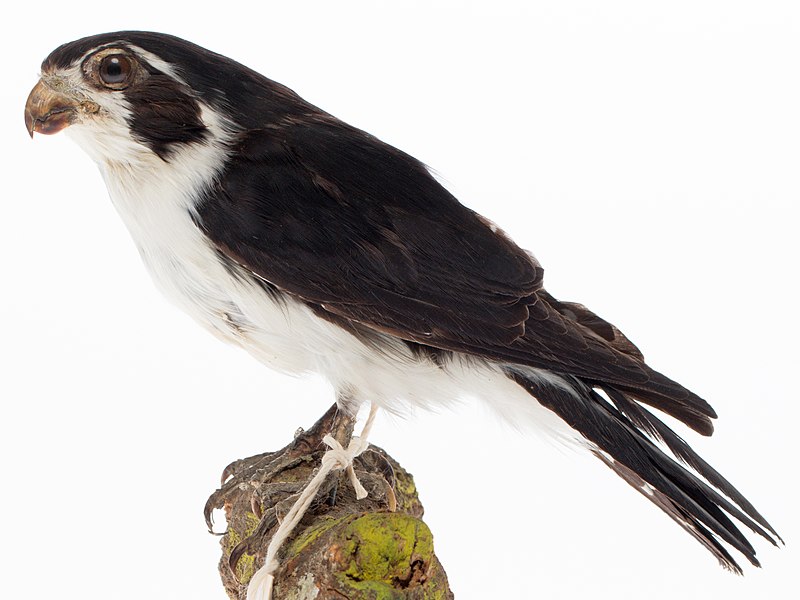
The Pied Falconet is a species of bird of prey belonging to the family Falconidae. It resides in countries such as Bangladesh, Bhutan, China, Hong Kong India and Vietnam amongst others.
The raptor prefers temperate forest areas for its habitat. This particular species belongs to the Microhierax genus which includes some of the smallest birds of prey on Earth and are also known as white-legged falconets due to their distinct colouring.
They build nests usually high up in trees or cliffs so they can protect themselves from predators while still being able to spot preys easily with their sharp eyesight.
These small but mighty creatures are an important part of our ecosystem – it’s vital that we continue protecting them.Scientific classification:
| Kingdom | Animalia |
| Phylum | Chordata |
| Class | Aves |
| Order | Falconiformes |
| Family | Falconidae |
| Genus | Microhierax |
| Species | M. melanoleucos |
18. Yellow-Vented Green Pigeon
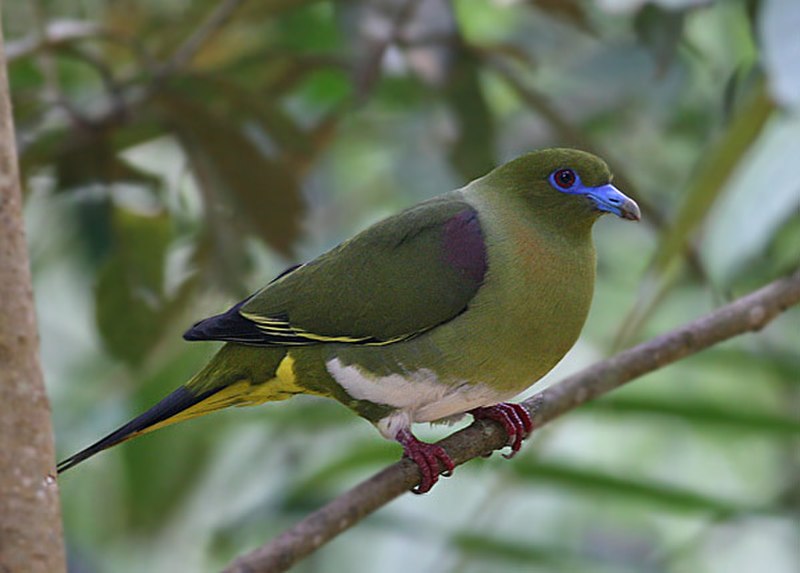
The yellow-vented green pigeon is a species of bird found in countries such as Laos, Malaysia, Thailand and Vietnam. It inhabits subtropical or tropical moist lowland forests, mangrove forests and montane forests where it can find food to eat.
This type of pigeon has an olive colour on its wings while the underside is white with a patch of bright yellow near its tail feathers giving them their name. They are often seen alone or in pairs but sometimes they form small flocks too.
The diet consists mainly of fruits like figs which helps spread seeds throughout their habitat aiding forest regeneration.
Despite being commonly seen across South East Asia these pigeons remain vulnerable due to destruction from deforestation for agriculture land development and hunting pressure making conservation efforts more important than ever before.Scientific classification:
| Kingdom | Animalia |
| Phylum | Chordata |
| Class | Aves |
| Order | Columbiformes |
| Family | Columbidae |
| Genus | Treron |
| Species | T. seimundi |
19. Grey-Faced Tit-Babbler
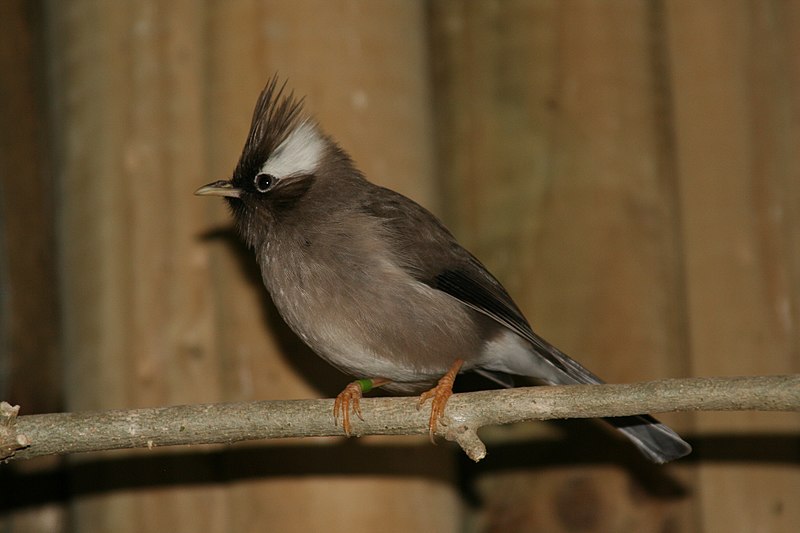
The grey-faced tit-babbler is a beautiful species of bird found in Cambodia, Laos and Vietnam. It has distinctive facial markings that give it its name – the face being mostly grey with patches of black around the eyes and beak.
Its body is mainly brownish-grey with some white stripes on its wings and tail feathers. This small songbird lives in subtropical or tropical moist lowland forests where it can find plenty of insects to feed on as well as fruits, seeds and nuts for an occasional snack.
They usually travel together in pairs or small groups but rarely join larger flocks like most other birds do. Unfortunately their population numbers are declining due to habitat loss so we need to take steps towards protecting them before they become endangered.Scientific classification:
| Kingdom | Animalia |
| Phylum | Chordata |
| Class | Aves |
| Order | Passeriformes |
| Family | Timaliidae |
| Genus | Mixornis |
| Species | M. kelleyi |
20. Tawny Fish Owl
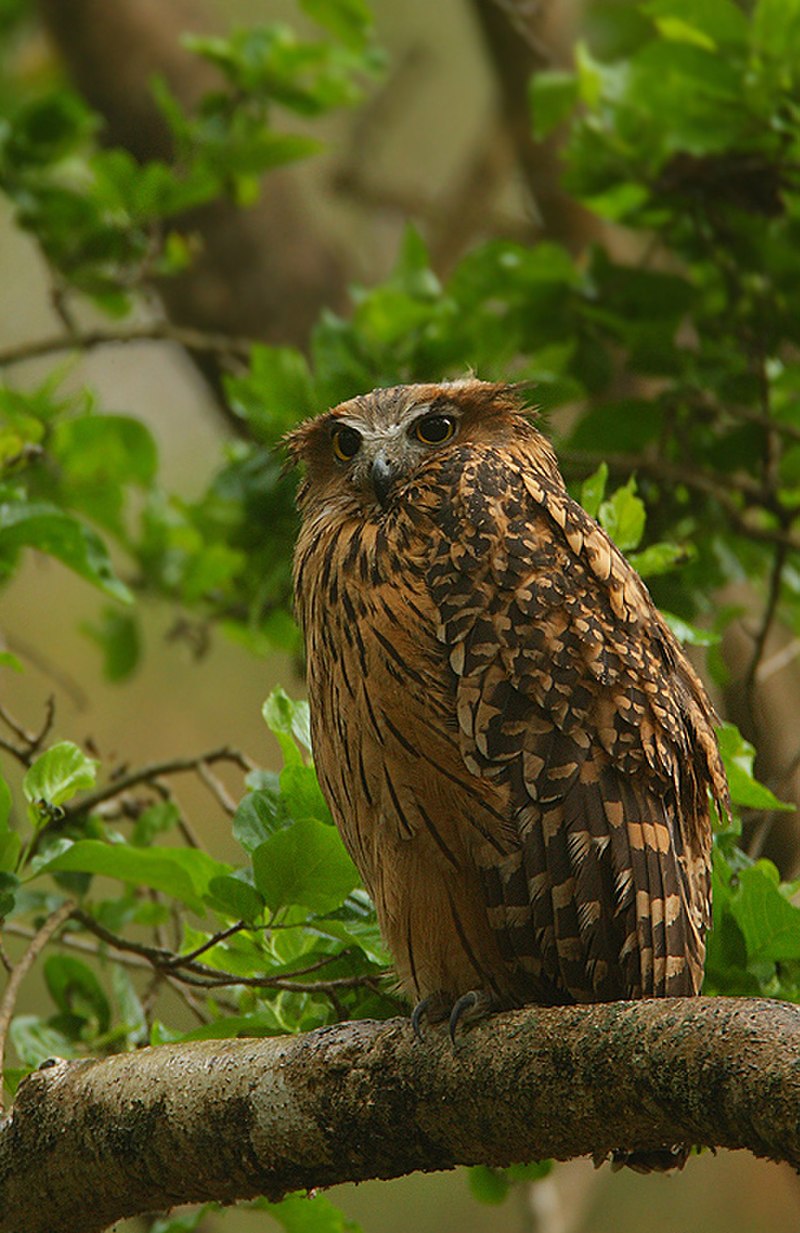
The Tawny Fish Owl is a species of owl native to southern Nepal, Bangladesh, Vietnam and China. It has yellow feet and was first described by Brian Houghton Hodgson in 1836.
This fish-eating bird feeds on small prey such as frogs and fish which it catches near rivers using its sharp talons.
The tawny coloration helps the owl blend into its natural environment, providing protection from predators while hunting for food at night or roosting during the day.
Its wide geographical range ensures that this species is listed as Least Concern by IUCN Red List due to its relatively stable populations across much of Asia despite some localized threats from human activities including habitat destruction and fragmentation through urban development .Scientific classification:
| Kingdom | Animalia |
| Phylum | Chordata |
| Class | Aves |
| Order | Strigiformes |
| Family | Strigidae |
| Genus | Ketupa |
| Species | K. flavipes |
21. Rufous-Backed Sibia
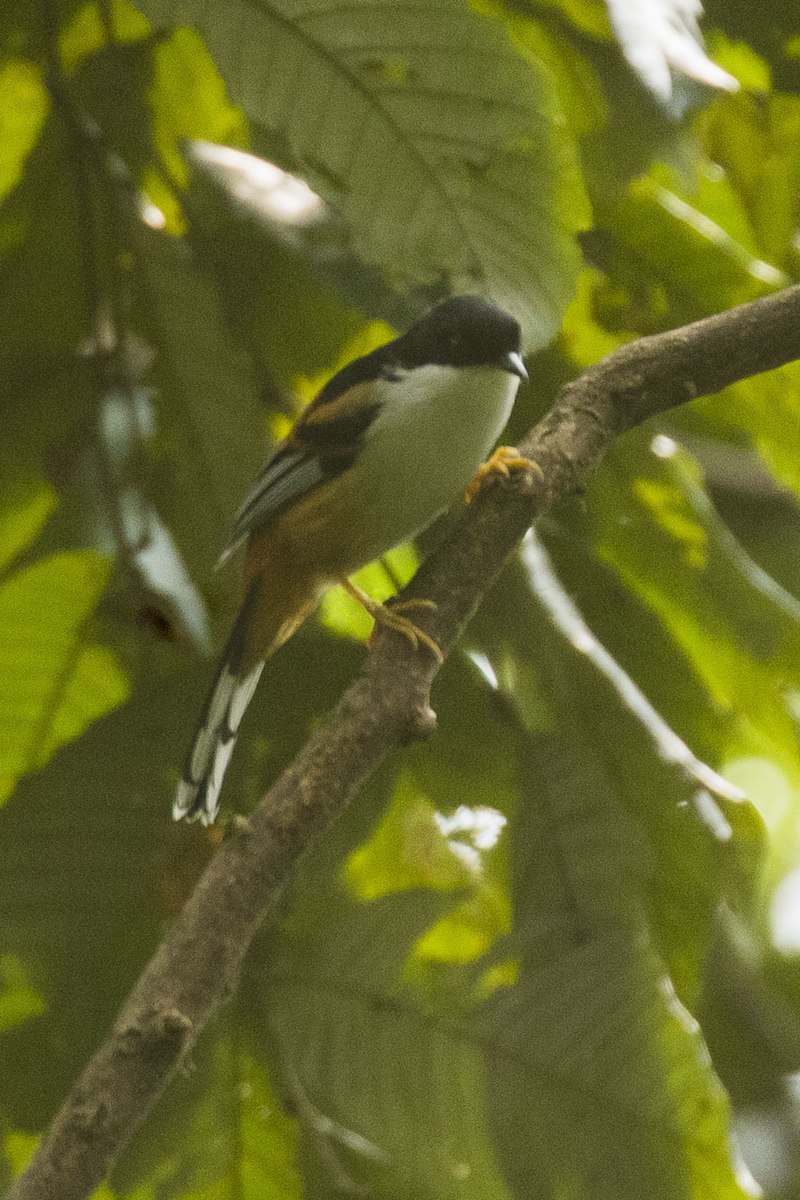
The Rufous-backed Sibia is a passerine bird of the Leiothrichidae family. It’s range stretches from the Himalayas to south-central Vietnam, and it prefers subtropical or tropical moist lowland and montane forests as its natural habitats.
This species is unique in that it stands alone in its genus – Leioptila annectens – but was formerly placed within Heterophasia.
In terms of physical appearance, this small bird has a distinctive rufous back with an olive crown streaked black on either side; white chin and throat; greyish brown upper breast; buffy yellow lower underparts, becoming duller towards the tail feathers which are tipped orange red when viewed up close.
A beautiful addition to any forest.Scientific classification:
| Kingdom | Animalia |
| Phylum | Chordata |
| Class | Aves |
| Order | Passeriformes |
| Family | Leiothrichidae |
| Genus | Leioptila Blyth, 1847 |
| Species | L. annectens |
22. White-Cheeked Laughingthrush
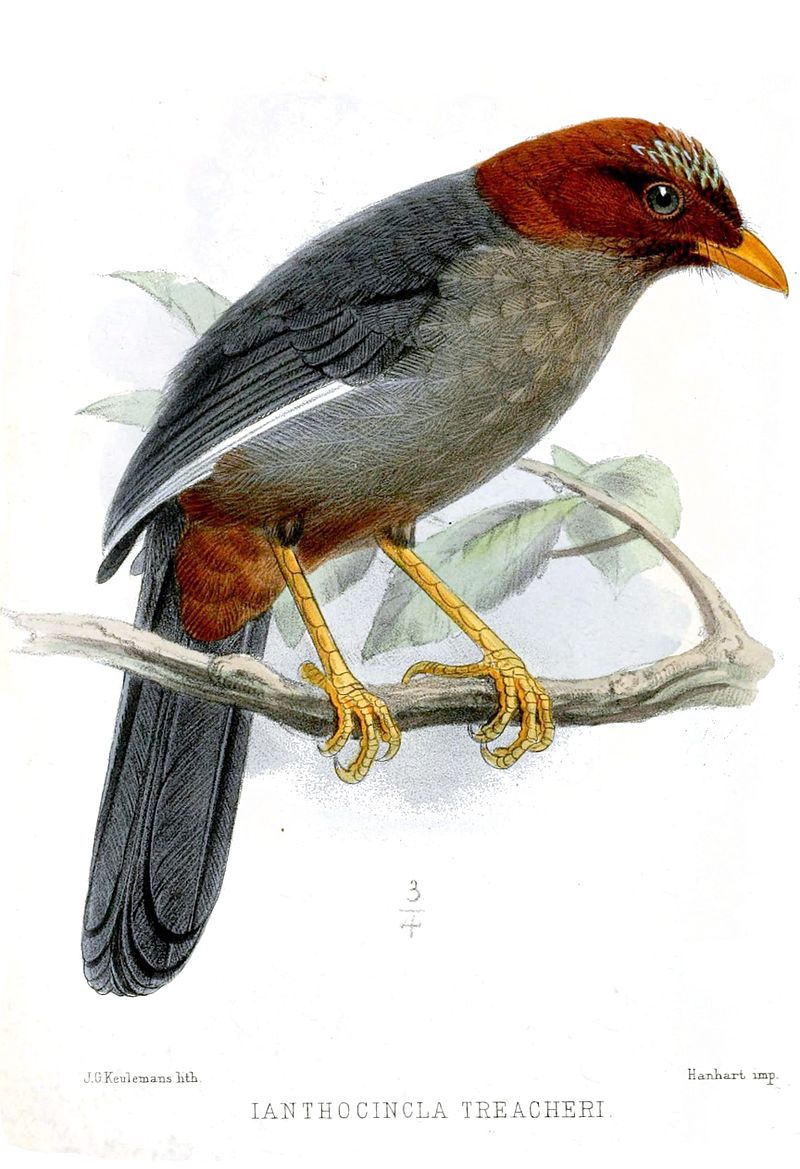
The White-cheeked Laughingthrush is a species of bird found in the forests of Cambodia, Laos and Vietnam. With its distinctive white cheeks stretching down to its neck, this medium sized songbird has an unmistakable appearance.
It’s natural habitats are subtropical or tropical moist lowland forests and montane forests at higher altitudes. The birds can often be seen foraging on the ground together in small flocks as they feed on insects, berries and seeds.
Recent molecular studies have shown that it belongs to the family Leiothrichidae; previously thought to belong to Garrulax genus instead. This beautiful bird adds life and colour among the trees with its melodious songs during mating season which helps attract potential mates.Scientific classification:
| Kingdom | Animalia |
| Phylum | Chordata |
| Class | Aves |
| Order | Passeriformes |
| Family | Leiothrichidae |
| Genus | Pterorhinus |
| Species | P. vassali |
23. Sooty Babbler
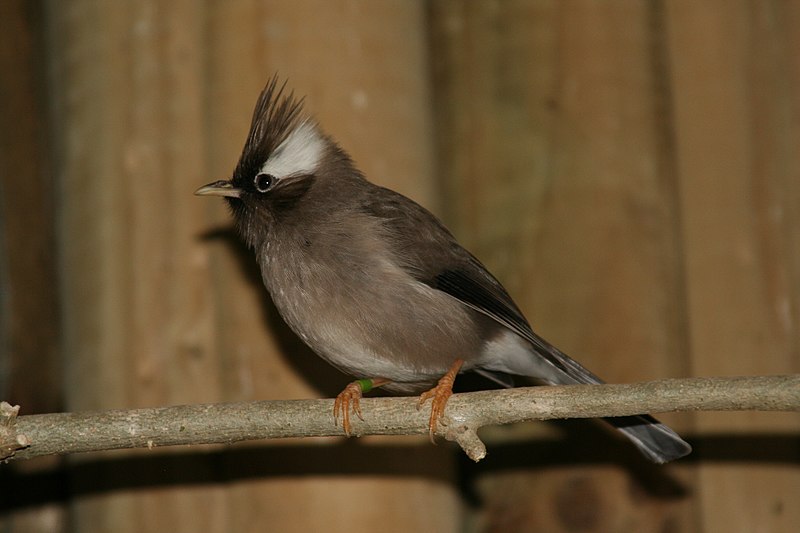
The Sooty Babbler is a species of bird belonging to the Timaliidae family. It can be found in Laos and Vietnam, living within subtropical or tropical moist lowland forests.
This small bird has grayish-brown feathers with white spots on its upper body that gradually turn into bars on their wings and tail. Sadly, it faces threats due to habitat loss caused by deforestation and human activities such as urbanization and agricultural expansion.
Conservation efforts are needed for this species’ survival if we want future generations to enjoy the beauty of these birds flying through our skies freely.Scientific classification:
| Kingdom | Animalia |
| Phylum | Chordata |
| Class | Aves |
| Order | Passeriformes |
| Family | Timaliidae |
| Genus | Stachyris |
| Species | S. herberti |
24. Grey Peacock-Pheasant
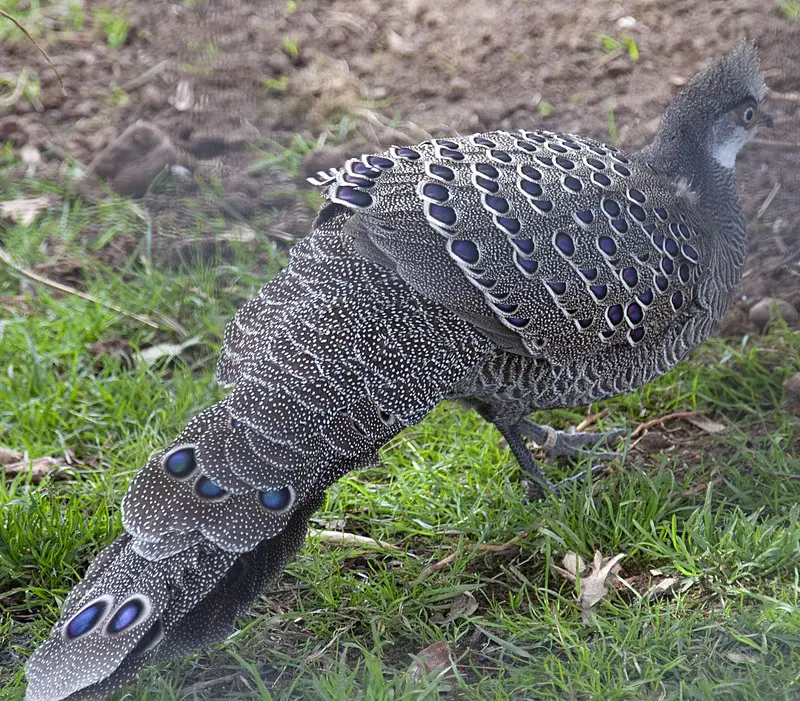
The grey peacock-pheasant, also known as the Burmese peacock-pheasant, is a large galliform bird endemic to Asia. It was first documented by English naturalist George Edwards in 1747 and depicted in his A Natural History of Uncommon Birds with an accompanying description.
The pheasant is grayish brown above with white stripes on its wings while the underparts are black and barred with white speckles; it has two spurs on each leg which gives this species its scientific name bicalcaratum meaning “two spurs”.
This beautiful bird can be seen living near wooded areas or grasslands where they feed mainly on insects and fruits.
Its primary threats include habitat destruction due to human activities such as logging, agricultural expansion, hunting for food or trade purposes.Scientific classification:
| Kingdom | Animalia |
| Phylum | Chordata |
| Class | Aves |
| Order | Galliformes |
| Family | Phasianidae |
| Genus | Polyplectron |
| Species | P. bicalcaratum |